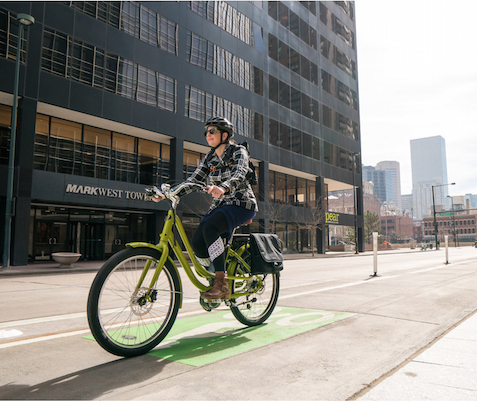3 Years After Fatal Crash, San Mateo County Adds Bike Lanes to Interchange
3:17 PM PST on December 6, 2013
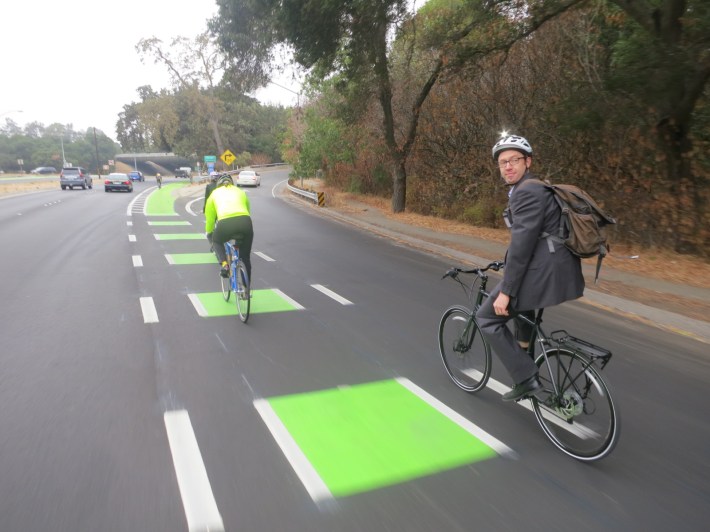
Nearly three years after 47-year-old Los Altos Hills resident Lauren Ward was killed by a truck driver while cycling on Alpine Road at Highway 280 in southern San Mateo County, eye-catching green and buffered bike lanes, the first for a freeway crossing in California, were finally installed there in mid-October.
Local residents and street safety advocates organized and persistently lobbied county officials to install bike lanes at the interchange, failing twice to secure grants from the San Mateo County Transportation Authority in 2011 and 2012. Under increasing pressure from residents and county leaders, public works staff cobbled together funds from three different sources in late 2012 and re-designed the interchange to include bike lanes. Traffic lanes were narrowed to 11 feet and wide green and buffered bike lanes were incorporated into the design using input from the Silicon Valley Bicycle Coalition.
An alternative design favored by bike advocates would have reduced the number of merge zones (where motorists need to cross the path of bicyclists to enter the highway) from three to two was also proposed. Caltrans rejected that option, saying it might cause delays for motorists. Nevertheless, the chosen design is still considered an enormous improvement over the previous complete lack of striping.
“Our goal is to create an environment on the road where people of all ages and skill levels feel comfortable riding a bike,” said SVBC Executive Director Corinne Winter. “Smart, visible infrastructure like this removes the ambiguity that plagued this intersection previously, and allows for all users in the road to feel confident while sharing the road.”
The buffers disappear and the bike lanes are dashed in sections where motorists need to merge across the bike lanes to enter Highway 280, making it obvious to everyone where the merging should take place. "If you ride south on Alpine Road, you'll see the huge improvement," said San Mateo County Bicycle and Pedestrian Advisory Committee Chair Steve Schmidt. "It seems like a more relaxed situation because it's clear where everyone should be."
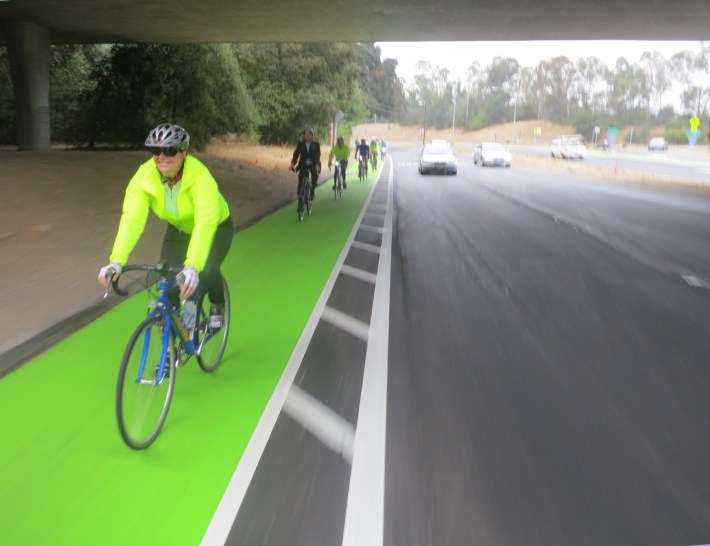
The 1,000-foot section of Alpine Road where it passes under Highway 280 was an unusual gap in the bike network. Continuous bike lanes had been installed long ago on Alpine Road between Menlo Park and Portola Valley, except for this short section.
Twice the SMCTA Board voted against funding the construction of bike lanes at the interchange, first in July 2011 then again in October 2012, when it distributed funds for other transportation projects using revenues generated by the Measure A half-cent sales tax, which generates roughly $60 million annually.
In the second funding attempt, the final cost of the bike lane project represented only 0.5 percent of the $104 million in total funds available from the SMCTA's Highway Program, intended to reduce traffic congestion on the county's highways and streets. Advocates for the project argued that a re-striped Alpine Road would add bike lanes and more clearly delineated travel lanes for motorists, which would reduce traffic congestion because both bicyclists and motorists would know where to expect each other on the roadway, and because some people would choose to bicycle instead of drive for some trips.
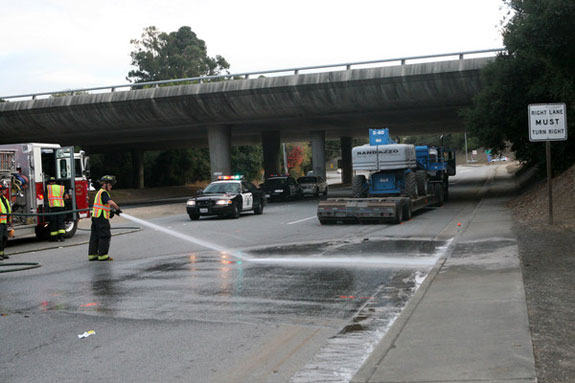
"Unlike the neighboring Sand Hill, Woodside, and Page Mill roads there is no clearly defined route for cyclists to cross through the intersection," wrote Portola Valley Bicycle, Pedestrian & Traffic Safety Committee member Shandon Lloyd in a letter to the SMCTA Board. "The traffic lanes are not clearly defined, making it dangerous for cyclists and confusing for drivers."
But the Transportation Authority's staff recommended against funding the Alpine Road project, saying it didn't qualify for the Highway Program. Project Manager Aiden Hughes said that "the program intent is to reduce congestion on commute corridors. There is no defined relationship to bicycles, pedestrians, or Complete Streets." Belmont's $120,000 Ralston Avenue Corridor Study, which proposed to study pedestrian and bicycle safety as well as ways to reduce traffic congestion on Ralston Avenue, was also disqualified because it "emphasized support for bicycle and pedestrian movement along with the overall improvement to the Ralston Corridor," according to Hughes.
At the same time, however, several major projects to either design or construct freeway interchanges were approved as part of the Measure A Highway Program without regard to whether they include non-motorized transportation infrastructure such as sidewalks, bike lanes, and multi-use paths. The SMCTA Board approved $36 million to demolish and reconstruct the Broadway Avenue & Highway 101 interchange in Burlingame in order to widen Broadway from four to seven travel lanes and modify the shape of the on-ramps and off-ramps. Including sidewalks and bike lanes in the project's design (none exist on the Broadway Avenue overpass today) didn't disqualify it from highway funding. Highway 101 interchange reconstruction projects at Holly Street in San Carlos and at Willow Avenue in Menlo Park were also awarded funds for environmental review and design, and these projects will include bike lanes and multi-use paths over the highway.
Apparently, in order to get these "congestion reduction" funds, it helps a lot to widen a road.
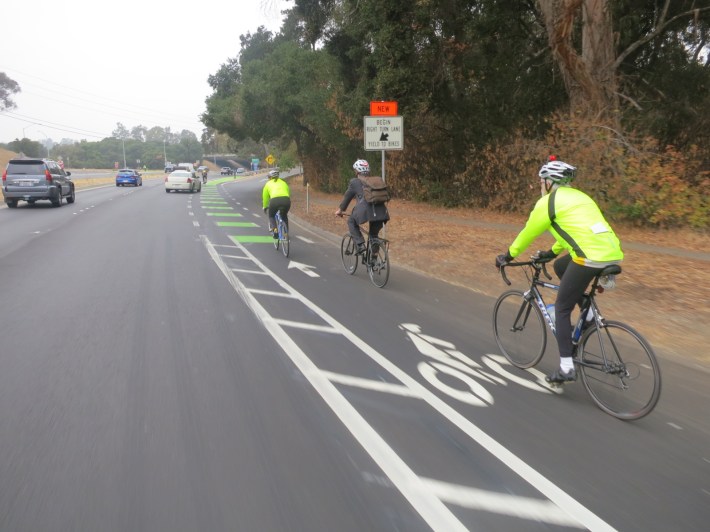
The public outcry that resulted from the disqualification of projects deemed "too Complete Streets" finally put enough pressure on the county to allocate its own street resurfacing funds to pay for 70 percent of the project's cost, with the SMCTA and Caltrans each pitching in 15 percent.
Alpine Road is now one of three Highway 280 interchanges in San Mateo County that include bike lanes. The others are Woodside Road and Sand Hill Road. A total of eight other Highway 280 interchanges and 15 Highway 101 interchanges in the county lack bike lanes or any other accommodations for cyclists and remain significant barriers that discourage both cycling and walking, resulting in more vehicle trips and greater traffic congestion.
"We need to re-do all of the interchanges in San Mateo County," said Winter. "This is a pivotal moment because the new Alpine/280 bike lanes demonstrate that we can make highway interchanges much safer with more modern designs."
Stay in touch
Sign up for our free newsletter
More from Streetsblog San Francisco
Update on Oakland DOT’s Lakeshore Protected Bike Lane Project
Public seems fairly positive and accepting towards the coming project. Let's hope it stays that way




